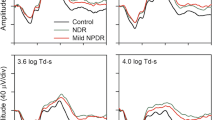Abstract
Both basic and clinical electrophysiological investigations have established that the oscillatory potentials (OP) and pattern electroretinogram (PERG) appear to originate from retinal sites that are in proximity. The OPs, subcomponents of the flash ERG, have been shown to reflect disturbances in retinal circulation, and OP amplitude attenuation or loss may be a distinctive feature of diabetic retinopathy. The PERG has been shown to be abnormal in diseases of the optic nerve and ganglion cell body. Thus its relative sensitivity for detection of electroretinal abnormalities in diabetic retinopathy is in question. This study assessed the sensitivity of ERG and OP measures in their detection of abnormalities of electroretinal function in diabetic patients referred to our laboratory. Thirty-five adult Type I patients were studied: 21 with background retinopathy (BR group), 14 with no evidence of background retinopathy (No BR group), and 25 normal control subjects.
Monocular OPs were recorded to full-field ganzfeld stimulation at four stimulus intensities. PERGs were obtained from checkerboard pattern reversal stimulation (checksize = 30′ arc). Peak-to-peak amplitude and peak implicit time measures of PERGs and OPs were obtained. Subsequent multivariate analysis demonstrated significant differences between normals and diabetic patients, including diabetics with no clinical evidence of retinopathy. In addition, the OP and PERG implicit times appear to be unaffected while OP and PERG amplitudes were diminished in patients with background retinopathy. Only OP amplitudes were found to be significantly diminished in diabetic patients with no photographic evidence of background retinopathy. The PERGs were normal in these patients. Overall, the OP amplitude measures were more sensitive than PERG measures in detecting abnormalities in patients with no retinal photographic evidence of background retinopathy.
Similar content being viewed by others
References
Arden GB, Hamilton AMP, Wilson-Holt J, Ryan S, Yudkin JS, Kurtz A. Pattern electroretinograms become abnormal when background diabetic retinopathy deteriorates to a preproliferative stage: possible use as a screening test. Br J Ophthalmol 1986; 70: 330–335.
Bobak P, Bodis-Wollner I, Harnois C. Pattern electroretinograms and visual evoked potentials in disease of the peripheral retinal pathway. Invest Ophthalmol Vis Sci 1981; 21: 490–493.
Bresnick GH, Korth K, Groo A, Palta M. Electroretinographic oscillatory potentials predict progression of diabetic retinopathy. Arch Ophthalmol 1984; 102: 1307–1311.
Brunette JR, Lafond G. Electroretinographic evidence of diabetic retinopathy - sensitivity of amplitude and time of response. Can J Ophthalmol 1983; 18: 285–289.
Coupland SG. Oscillatory potential changes related to stimulus intensity and light adaptation. Paper presented at the XXIVth Symposium of ISCEV, Palermo, Sicily.
Coupland SG. Pattern ERG and oscillatory potential measures in diabetic retinopathy. Invest Ophthalmol Vis Sci Suppl 1985; 26: 215.
Coupland SG, Kirkham TH. Digital subtraction of eye movement artefact from pattern ERG recordings. Neuro-Ophthalmology 3: 281–284.
Coupland SG, Kirkham TH. Electroretinography and nystagmus: subtraction of eye movement artefact. Can J Ophthalmol 1981; 16: 192–194.
King-Smith PE, Loffing DH, Jones R. Rod and cone ERGs and their oscillatory potentials. Invest Ophthalmol Vis Sci 1986; 27: 270–273.
Kirkham TH, Coupland SG. Abnormal pattern electroretinograms with macular cherry-red spots: Evidence for selective ganglion cell damage. Curr Eye Res 1981; 1: 367–375.
Kirkham TH, Coupland SG. The pattern electroretinogram in optic nerve demyelination. Can J Neurol Sci 1983; 10: 256–261.
Klein R, Klein BEK, Moss SE, Davis MD, DeMets DL. The Wisconsin epidemiologic study of diabetic retinopathy, Part 2: prevalence and risk of DR when age at diagnosis is less than 30 years. Arch Ophthalmol 1984; 102: 520–546.
Kojima M, Zrenner E. Off-components in response to brief light flashes in the oscillatory potential of the human electroretinogram. Albrecht von Graefes Arch Klin Exp Ophthalmol 1978; 206: 107–120.
Lachapelle P, Little JM, Polomeno RC. The photopic ERG in congenital stationary night blindness with myopia. Invest Ophthalmol Vis Sci 1983; 24: 442–450.
Maffei L, Fiorentini A. Electroretinographic responses to alternate gratings before and after section of the optic nerve. Science 1981; 211: 953–954.
Mashima Y, Oguchi Y. Clinical study of the pattern electroretinogram in patients with optic nerve damage. Doc Ophthalmol 1985; 61: 91–96.
Simonsen SE. Electroretinogram in diabetes. In: The clinical value of electroretinography. Basel: Karger, 1966; 403–412.
Simonsen SE. The value of the oscillatory potential in selecting juvenile diabetics at risk for developing proliferative retinopathy. Acta Ophthalmol 1980; 58: 865–878.
Trick GL. Retinal potentials in patients with primary open-angle glaucoma: Physiological evidence for temporal frequency tuning deficits. Invest Ophthalmol Vis Sci 1985; 26: 1750–1758.
Wachtmeister L, Dowling JE. The oscillatory potentials of the mudpuppy retina. Invest Ophthalmol Vis Sci 1978; 17: 1176–1188.
Wanger P, Persson HE. Pattern-reversal ERGs in ocular hypertension. Doc Ophthalmol 1985; 61: 27–32.
Yonemura D, Aoki T, Tsuzuki K. Electroretinogram in diabetic retinopathy. Arch Ophthalmol 1962; 68: 19–29.
Author information
Authors and Affiliations
Rights and permissions
About this article
Cite this article
Coupland, S.G. A comparison of oscillatory potential and pattern electroretinogram measures in diabetic retinopathy. Doc Ophthalmol 66, 207–218 (1987). https://doi.org/10.1007/BF00145234
Issue Date:
DOI: https://doi.org/10.1007/BF00145234




